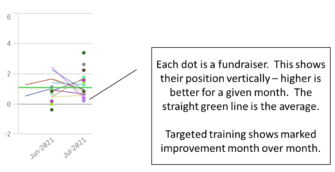Quantifying the Donor Experience At Scale
What gets measured gets managed. How many brands out there are regularly measuring donor experience? How many people read that last sentence and aren’t even sure what it means?
You’d be excused, hell you’d be applauded, since donor experience is thrown around ad nauseam with little or no practical definition, much less linkage to fundraising and making money.
I can offer a boring definition but much like that picture and 1,000 words, a couple real examples do a better job.
- “who the fuck gave you the right to call me? just because i wanted to support a cause that doesn’t mean you can ring my phone whenever you like! i am never ever getting involved with your organisation ever again!”
- “Steve [name changed] was really kind and friendly. he was very engaging to talk to! he was very informative and knowledgeable, too. he proposed a donation that was a bit too high out of my price range and was quick to adapt and accommodate me to a donation that fit my budget as I care deeply about the refugee crisis. there was no judgment or guilt tripping – only appreciation and gratefulness for my contribution.”
This certainly feels like an In Living Color set of experiences and from the only source that matters–the human beings giving us money.
We have tens of thousands more of these examples and get 100s more each day. How? We measure donor experience – i.e. we ask people for feedback about their interaction with the charity within hours of the interaction occurring. This is a continuous business process, not a sample or survey.
But, what to do with this rich but hard to manage text data? Everything can be turned into numbers and made measurable to then manage it. At scale.
Here are the positive/negative sentiment scores for those two experiences. We combine the positive and negative as a ratio, higher scores mean more positive. It starts by coding and scoring individual words and sentence fragments. There is some more math involved but you get the gist. I for one like knowing the F-bomb is the negative equivalent of using the word, kind. Yin and yang.

There are lots of ways this gets managed – i.e. used. We change supporter experience at the individual level using business rules and automation to send tailored responses back to folks and not just for problem resolution but for everyone.
But, this data is also invaluable for managing front line acquisition staff, namely our canvassers and telefundraisers. Every donor comment can be linked back to the fundraiser.

This chart shows canvassers and telefundraisers as individual bars. The height reflects the donor experience sentiment, higher is better. The green line is the running average.
How do we use this? We use it to re-train those below the running average. This isn’t punitive, its restorative.
And it makes the client more money as positive experiences increase likelihood of sticking around. The opposite is also true and all our data definitively proves it. Measuring and managing the donor experience is a way to raise more money without having to crank up the diminishing return, solicitation machine.
Here is month over month improvement made possible by 1) having the data, and 2) in a timely fashion and at 3) an individual level. Donor experience is almost entirely under every organization’s control. It’s happening and materially impacting your return whether you measure and manage it or not.

How are you measuring and managing your donors’ experience to improve it at the individual level? How are using donor experience data to change process or fundraiser training and create a rising tide effect?
Kevin


